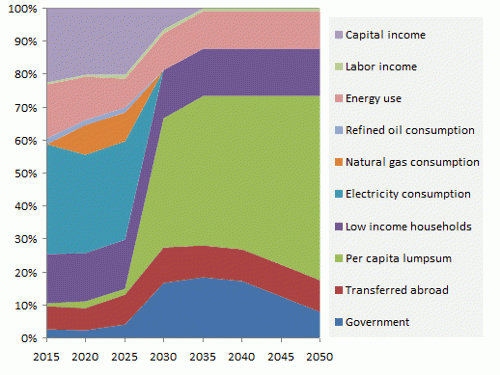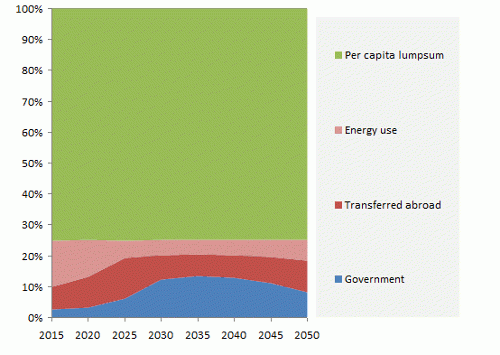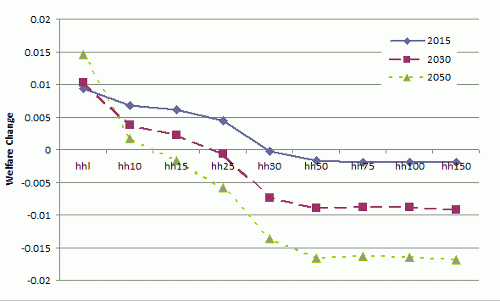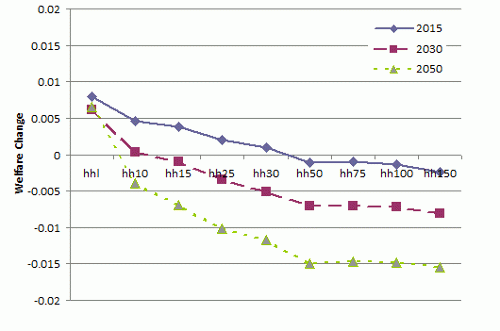The distributional impacts of energy and climate policies can be assessed across a number of dimensions. Goulder and Parry (2008) note that two dimensions in particular have attracted attention: the impact on energy-intensive industry and the impact across households of differing incomes.
The income-distribution dimension plays a particularly significant role in policy circles given the results from a large number of studies indicating that energy taxes – and by extension carbon-pricing policies – are regressive. Studies that have documented the regressivity of energy taxes include Bull et al. (1994), Metcalf (1999), Dinan and Rogers (2002), West and Williams (2004), and Bento et al. (2009).
These various studies make an important set of points, two of which stand out.
- First, how energy tax revenue is used affects the ultimate incidence of the green tax reform.
The incidence of an environmental or energy tax reform can differ significantly from that of the tax considered in isolation. The use of the revenue can undo any regressivity in the environmental or energy tax through a progressive use of funds.
- Second, regressivity impacts are sensitive to assumptions about whether households are ranked over an annual or lifetime income measure.
Lifetime income measures reduce the regressivity of energy tax and carbon pricing policies as shown by Poterba (1989 and 1991) and Hassett et al. (2009), and others.
New evidence on income affects
In a recent study we use a new dynamic recursive model of the US economy that incorporates household heterogeneity across income groups and regions to evaluate the distributional impacts of carbon pricing in an annual income framework (Rausch et al. 2010). Our model, the USREP model, tracks nine different income groups and twelve different geographic regions within the US. Recently proposed legislation includes the Waxman-Markey House bill, the similar Kerry-Boxer bill in the Senate that has been replaced by a Kerry-Lieberman draft bill, and the Cantwell-Collins Senate bill that takes a different approach to revenue allocation. We consider allocation schemes motivated by these recent proposals applied to a comprehensive national cap and trade system that limits cumulative greenhouse gas emissions over the control period to 203 billion metric tons. The policy target approximates national goals identified in pending legislation.
Allowance allocation in the various bills is highly complex and the first part of our analysis is to determine how households are affected by the various allowance allocation schemes. Figure 1 shows the results of our allowance allocation between 2012 and 2050.
Figure 1. The allocation of allowance value according to model distribution instruments
(a) Targeted allowance allocation scheme
(b) Per capita dividend scheme
Our analysis reveals a number of results.
- First, scenarios based on the Waxman-Markey and Kerry-Boxer (or Kerry-Lieberman) allowance allocation schemes are more progressive in early years than scenarios based on the Cantwell-Collins proposal.
Scenarios based on the allowance allocation mechanisms in the first set of bills are termed Targeted Allowance Allocation Scenarios (TAAS) while scenarios based on the Cantwell-Collins proposal are termed Per Capita Dividend Schemes (PCDS). We emphasise, however, that the overall distributional impact of these proposals depend on all the elements contained in these legislative proposals and not just the cap and trade programmes on which we focus.
Nonetheless the allowance allocation schemes are important determinants of the overall distributional impact of these bills. Figures 2 and 3 show the distributional impacts of carbon pricing with the allowance allocations for these two scenarios in various years. The graphs measure changes in welfare from the policies measured as the percentage change in equivalent variation relative to full income for households in each income group.
Figure 2. Welfare change by income group, US average (Scenario TAAS).
Figure 3. Welfare change by income group, US average (Scenario PCDS)
- Second, scenarios based on the Cantwell-Collins allocation proposal have lower welfare costs due to lower redistribution to low income households and consequent lower income-induced increases in energy demand, and higher savings rates of higher income households.
- Third, we find that the Waxman-Markey and Kerry-Boxer (or Kerry-Lieberman) allocation schemes appear to overcompensate some adversely affected income groups and regions early on though this dissipates over time as the allocation scheme evolves to something closer to a per capita dividend approach.
- Fourth, the allocation schemes in all proposals are progressive over the lower half of the income distribution and essentially proportional in the upper half of the income distribution.
- Finally we find that carbon pricing by itself, ignoring the return of carbon revenues through allowance allocations, is somewhere between neutral and modestly progressive.
We trace our result to the dominance of the sources side over the uses side impacts of the policy. Our finding stands in sharp contrast to previous work that has focused only on the uses side, and has hence found energy taxation to be regressive. The treatment of transfers is also important in driving this result. Lower income households derive a large fraction of income from government transfers and, reflecting the reality that these are generally indexed to inflation, we hold the transfers constant in real terms. As a result this source of income is unaffected by carbon pricing, while wage and capital income is affected.
Figure 4 shows the roles that sources and uses side heterogeneity play in driving the burden impacts across households. The blue lines in each panel show the actual carbon pricing burden when we ignore the distribution of allowances and allowance value. The red lines show a counterfactual distribution where we assume all households have the same expenditure shares on different consumption goods regardless of income. Any differences in burden then are driven by differences in sources of income across income groups. The green lines show a counterfactual distribution where we assume all households have the same factor income shares regardless of income. Any differences in burden then are driven by differences in uses of income across income groups. Use-side impacts (green lines) show the regressive result found in previous analyses. Sources-side impacts, in contrast, are progressive.
Figure 4. Relative sources vs. uses side impacts across income distribution
We emphasise that our scenarios focused solely on the distributional implications due to carbon pricing and the allocation of allowance revenue, and that we did not attempt to model each bill in its entirety. More precise representation of the many programmes described in these bills could give different outcomes and there is inevitable uncertainty in economic forecasts of this type. Nor have we attempted to measure the benefits of the policies in the form of reduced climate impacts.
Conclusion
This analysis contributes to a growing literature on the impacts of climate policy on households. The general equilibrium analysis improves on previous analyses that focus on uses side impacts only. Differential impacts on income will be important and this study should help guide researchers in thinking about burden impacts more fully in future work.
References
Bento, Antonio M, Lawrence H Goulder, Mark R Jacobsen, and Roger H von Haefen (2009), "Distributional and Efficiency Impacts of Increased US Gasoline Taxes", American Economic Review, 99(3):667-699.
Bull, Nicholas, Kevin A Hassett, and Gilbert E Metcalf (1994), "Who Pays Broad-Based Energy Taxes? Computing Lifetime and Regional Incidence", Energy Journal 15(3):145-164.
Dinan, Terry, and Diane Lim Rogers (2002), "Distributional Effects of Carbon Allowance Trading: How Government Decisions Determine Winners and Losers", National Tax Journal, 55(2):199-221.
Goulder, Lawrence H and Ian WH Parry (2008), "Instrument Choice in Environmental Policy, Review of Environmental Economics and Policy, 2(2):152-174.
Hassett, Kevin A, Aparna Mathur, and Gilbert E Metcalf (2009), "The Incidence of a US Carbon Tax: A Lifetime and Regional Analysis", The Energy Journal, 30(2):157-179.
Metcalf, Gilbert E (1999), "A Distributional Analysis of Green Tax Reforms", National Tax Journal, 52(4):655-681.
Poterba, James (1989), "Lifetime Incidence and the Distributional Burden of Excise Taxes", American Economic Review, 79(2):325-330.
Poterba, James (1991), "Is the Gasoline Tax Regressive?", Tax Policy and the Economy, 5:145-164.
Rausch, Sebastian, Gilbert E Metcalf, John M Reilly, and Sergey Paltsev (2010), "Distributional Implications of Alternative U.S. Greenhouse Gas Control Measures", NBER Working Paper 16053, Cambridge, MA.
West, Sarah E and Roberton C Williams, III (2004), "Estimates from a Consumer Demand System: Implications for the Incidence of Environmental Taxes", Journal of Environmental Economics and Management, 47(3):535-558.











